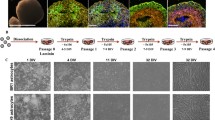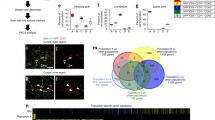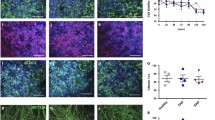Summary
Studies of brain cell function and physiology are hampered by the limited availability of imortal human brain-derived cell lines, as a result of the technical difficulties encountered in establishing immortal human cells in culture. In this study, we demonstrate the application of recombinant DNA vectors expressing SV40 T antigen for the development of immortal human cell cultures, with morphological, growth, and functional properties of astrocytes.
Primary human astrocytes were transfected with the SV40 T antigen expression vectors, pSV3neo or p735.6, and cultures were established with an extended lifespan. One of these cultures gave rise to an immortal cell line, designated A735. All the human SV40-derived lines retained morphological features and growth properties of type 1 astrocytes. Immunohistochemical studies and Western blot analysis of the intermediate filament proteins and glutamine synthetase demonstrated a differentiated but immature astrocyte phenotype. Transport of γ-amino butyric acid and glutamate were examined and found to be by a glial-specific mechanism, consistent with the cell lines’ retaining aspects of normal glial function.
We conclude that methods based on the use of SV40 T antigen can successfully immortalize human astrocytes, retaining key astrocyte functions, but T antigen-induced proliferation appeared to interfere with expression of glial fibrillary acidic protein. We believe A735 is the first documented nontumor-derived human glial cell line which is immortal.
Similar content being viewed by others
References
Akimoto, J.; Itoh, H.; Miwa, T.; Ikeda, K. Immunohistochemical study of glutamine synthetase expression in early glial development. Dev. Brain Res. 72:9–14; 1993.
Bigner, D. D.; Bigner, S. H.; Ponten, J.; Westermark, B.; Mahaley, M. S.; Ruoslahti, E.; Herschmaan, H.; Wikstrand, C. J. Heterogeneity of genotypic and phenotypic characteristics of fifteen permanent cell lines derived from human gliomas. J. Neuropathol. Exp. Neurol. 40:201–229; 1981.
Bottenstein, J. E. In: Bottstein, J. and Sato, G., eds. Cell culture in the neurosciences. New York: Plenum Press; 1985:3–43.
Brooks, S. E.; Amsterdam, D.; Hoffman, L. M.; Adachi, M.; Schneck, L. Cytology, growth characteristics and cellular alterations following SV40-induced transformation of human foetal brain cells derived from A Gm2 gangliosidosis and control. J. Cell Sci. 38:211–223; 1979.
Chang, S. E. In vitro transformation of human epithelial cells. Biochem. Biophys. Acta. 823:161–194; 1986.
Dahlstrand, J.; Collins, V. P.; Lendahl, U. Expression of the class VI intermediate filament nestin in human central nervous system tumors. Cancer Res. 52:5334–5341; 1992.
Danks, R. A.; Orian, J. M.; Gonzales, M. F.; Tan, S. S.; Alexander, B.; Mikoshiba, K.; Kaye, A. H. Transformation of astrocytes in transgenic mice expressing SV40 T antigen under the transcriptional control of the glial fibrillary acidic protein promoter. Cancer Res. 55:4302–4310; 1995.
Davey, P.; Rauth, A. M.; Mason, L.; Addy, L. Spontaneous phenotypic and karyotypic progression in the SV40 transfected cell line SVG during prolonged passage in vitro. J. Neuro-Oncol. 8:13–22; 1990.
Estin, C.; Vernadakis, A. Primary glial cells and brain fibroblasts: interactions in culture. Brain Res. Bull. 16:723–731; 1986.
Eves, E. M.; Tucker, M. S.; Roback, J. D.; Downen, M.; Rosner, M. R.; Wainer, B. H. Immortal rat hippocampal cell lines exhibit neuronal and glial lineages and neurotrophin gene expression. Proc. Natl. Acad. Sci. 89:4373–4377; 1992.
Evrard, C.; Galiana, E.; Rouget, P. Establishment of ‘normal’ nervous cell lines after transfer of polyoma virus and adenovirus into murine brain cells. EMBO J. 5:3157–3162; 1986.
Frame, M. C.; Freshney, R. I.; Vaughan, P. F. T.; Graham, D. I.; Shaw, R. Interrelationship between differentiation and malignancy-associated properties in glioma. Br. J. Cancer 49:269–280; 1984.
Frederiksen, K.; Jat, P. S.; Valtz, N.; McKay, R. D. G. Immortalisation of precursor cells from the mammalian CNS. Neuron 1:439–448; 1988.
Freshney, R. I. Culture of animal cells, manual of basic technique. 3rd ed. Chichester, UK: Wiley & Sons; 1994.
Geller, H. M.; Dubois-Dalcq, M. Antigenic and functional characterization of a rat central nervous system-derived cell line immortalized by a ret-roviral vector. J. Cell Biol. 107:1977–1986; 1988.
Groves, A. K.; Entwistle, A.; Jat, P. S.; Noble, M. The characterization of astrocyte cell lines that display properties of glial scar tissue. Dev. Biol. 159:87–104; 1993.
Hara, A.; Sakai, N.; Yamada, H.; Nikawa, S.; Ohno, T.; Tanaka, T.; Mori, H. Proliferative assessment of GFAP-positive and GFAP-negative glioma cells by nucleolar organiser region staining. Surg. Neurol. 36:190–194; 1991.
Harlow, E.; Lane, D. Antibodies. A laboratory manual. Cold Spring Harbor: Cold Spring Harbor Laboratory Press; 1988.
Hayflick, L.; Moorhead, P. S. The serial cultivation of human diploid cell strains. Exp. Cell Res. 75:585–621; 1961.
Huschtscha, L. I.; Holliday, R. Limited and unlimited growth of SV40-transformed cells from human diploid MRC-5 fibroblasts. J. Cell Sci. 63:77–99; 1983.
Kennedy, P. G. E.; Fok-Seang, J. Studies on the development, antigenic phenotype and function of human glial cells in tissue culture. Brain 109:1261–1277; 1986.
Kennedy, P. G. E.; Watkins, B. A.; Thomas, D. G.; Noble, M. D. Antigenic expression by cells derived from human gliomas does not correlate with morphological classification. Neuropathol. Appl. Neurobiol. 13:327–347; 1987.
Major, E. O.; Miller, A. E.; Mourrain, P.; Traub, R. G.; Widt, D.; Sever, J. Establishment of a line of human fetal glial cells that supports JC virus multiplication. Proc. Natl. Acad. Sci. USA 82:1257–1261; 1985.
Martinez-Hernandez, A.; Bell, K. P.; Norenberg, M. D. Glutamine synthetase: glial localization in brain. Science (Wash DC) 195:1356–1358; 1997.
Mayne, L. V. Strategies for immortalising human primary cells and the steps that lead to immortality. In: Wilson, G., et al., ed. Pharmaceutical applications of cell and tissue culture to drug transport. New York: Plenum Press; 1991:347–354.
Mayne, L. V.; Price, T. N. C.; Moorwood, K.; Burke, J. F. Development of immortal human fibroblast cell lines. In: Freshney, R. I.; Freshney, M. G., ed. Culture of immortalized cells. Chickester, UK: J. Wiley & Sons, Inc.; 1996:77–93.
McCarthy, K. D.; de Vellis, J. Preparation of separate astroglial and oligodendrocyte cell cultures from rat cerebral tissue. J. Cell Biol. 85:890–902; 1980.
Morrison, R. S.; de Vellis, J. Growth of purified astrocytes in a chemically defined medium. Proc. Natl. Acad. Sci. USA 78:7205–7209; 1981.
Mrak, R. E.; Sheng, J. G.; Griffin, W. S. T. Glial cytokines in Alzheimer’s Disease—review and pathogenic implications. Human Pathol. 26:816–823; 1995.
Nishiyama, A.; Onda, K.; Washiyama, K.; Kumanishi, T.; Kuwano, R.; Sakimura, K.; Takahashi, Y. Differential expression of glial fibrillary acidic protein in human glioma cell lines. Acta Neuropathol. 78:9–15; 1989.
Norenberg, M. D.; Martinez-Hernandez, A. Fine structural localization of glutamine synthetase in astrocytes of rat brain. Brain Res. 161:303–310; 1979.
Norton, W. T.; Farooq, M. Astrocytes cultured from mature brain derive from glial precursor cells. J. Neurosci. 9:769–775; 1989.
Pekny, M.; Eliasson, C.; Chien, C.-L.; Kindblom, L. G.; Liem, R.; Hamberger, A.; Betsholtz, C. GFAP-deficient astrocytes are capable of stellation in vitro when cocultured with neurons and exhibit a reduced amount of intermediate filaments and an increased cell saturation density. Exp. Cell Res. 239:332–343; 1998.
Pereira-Smith, O. M.; Smith, J. R. Genetic analysis of indefinite division in human cells: identification of four complementation groups. Proc. Natl. Acad. Sci. USA 85:6042–6046; 1988.
Pfrieger, F. W.; Barres, B. A. New views on synapse-glia interactions. Curr. Opin. Neurobiol. 6:615–621; 1996.
Price, T. N. C.; Moorwood, K.; James, M. R.; Burke, J. F.; Mayne, L. V. Cell cycle progression, morphology and contact inhibition are regulated by the amount of SV40 T antigen in immortal human cells. Oncogene 9:2897–2904; 1994.
Raff, M. C.; Fields, K. L.; Hakomori, S.-I.; Mirsky, R.; Pruss, R. M.; Winter, J. Cell type specific markers for distinguishing and studying neurons and the major classes of glial cells in culture. Brain Res. 174:283–308; 1979.
Raff, M. C. Subclass of astrocytes in culture: what should we call them? Differentiation and functions of glial cells. New York: Alan R. Liss, Inc.; 1990:17–23.
Rothstein, J. D.; Dykes-Hoberg, M.; Pardo, C. A.; Bristol, L. A.; Jin, L.; Kuncl, R.; Kanai, Y.; Hediger, M. A.; Wang, Y.; Schielke, J. P.; Welty, D. F. Knockout of glutamate transporters reveals a major role of astroglial transport in excitotoxicity and clearance of glutamate. Neuron 16:675–686; 1996.
Rothstein, J. S.; Van Kammen, M.; Levey, A. I.; Martin, L.; Kuncl, R. W. Selective loss of glial glutamate transporter GLT-1 in amyotrophic lateral sclerosis. Ann. Neurol. 38:73–84; 1995.
Rutka, J. T.; Kleppe-Hoifodt, H.; Emma, D. A.; Giblin, J. R.; Dougherty, D. V.; McCulloch, J. R.; DeArmond, S. J.; Rosenbaum, M. L. Characterisation of normal human brain cultures. Evidence for the outgrowth of leptomeningeal cells. Lab. Invest. 55:71–85; 1986.
Rutka, J.; Smith, S. L. Transfection of human astrocytoma cells with glial fibrillary acidic protein complementary DNA: analysis of expression, proliferation, and tumorigenicity. Cancer Res. 53:3624:3631; 1993.
Rutka, J. T.; Hubbard, S. L.; Fukuyama, K.; Matsuzawa, K.; Dirks, P. B.; Becker, L. E. Effects of antisense glial fibrillary acidic protein complementary DNA on the growth, invasion, and adhesion of human astrocytoma cells. Cancer Res. 54:3267–3272; 1994.
Ryder, E. F.; Snyder, E. Y.; Cepko, C. L. Establishment and characterization of multipotent neural cell lines using retrovirus vector-mediated oncogene transfer. J. Neurobiol. 21:356–357; 1989.
Sambrook, J.; Fritsch, E. F.; Maniatis, T. Molecular cloning. A laboratory manual. 2nd ed. Cold Spring Harbor: Cold Spring Harbor Laboratory Press; 1989.
Schousboe, A.; Larsson, O. M.; Drejer, J.; Krogsgaard-Larsen, P.; Hertz, L. Uptake and release processes for glutamine, glutamate and GABA in cultured neurons and astrocytes. New York: Alan R. Liss, Inc., 1983:297–315.
Seyfried, T. N.; Yu, R. K. Ganglioside GD3: structure, cellular distribution, and possible function. Mol. Cell. Biochem. 68:3–10; 1985.
Shaw, R. Interrelationship between differentiation and malignancy-associated properties in glioma. Br. J. Cancer 49:269–280; 1984.
Shay, J. W.; Wright, W. E. Quantitation of the frequency of immortalization of normal human diploid fibroblasts by SV40 large T antigen. Exp. Cell Res. 184:109–118; 1989.
Southern, P. J.; Berg, P. Transformation of mammalian cells to antibiotic resistance with a bacterial gene under control of the SV40 early region promoter. J. Mol. Appl. Genet. 1:327–341; 1982.
Toda, M.; Miura, M.; Asou, H.; Toya, S.; Uyemura, K. Cell growth suppression of astrocytoma C6 cells by glial fibrillary acidic protein cDNA transfection. J. Neurochem. 63:1975–1978; 1994.
Tohyama, T.; Lee, V. M.-Y.; Rorke, L. B.; Marvin, M.; McKay, R. D. G.; Trojanowski, J. Q. Nestin expression of embryonic human neuroepithelium and in human neuroepithelial tumor cells. Lab. Invest. 66:303–313; 1992.
Tornatore, C.; Baker-Cairns, B.; Yadid, G.; Hamilton, R.; Meyers, K.; Atwood, W.; Cummins, A.; Tanner, V.; Major, E. Expression of tyrosine hydroxylase in an immortalized human fetal astrocyte cell line: in vitro characterization and engraftment into the rodent striatum. Cell Transplant. 5:145–163; 1996.
Towbin, H.; Staehelin, T.; Gordon, J. Electrophoretic transfer of proteins from acrylamide gels to nitrocellulose sheets: procedure and some applications. Proc. Natl. Acad. Sci. USA 76:4350–4354; 1979.
Westphal, M.; Nausch, H.; Herrmann, H.-D. Antigenic staining patterns of human glioma cultures: primary cultures, long-term cultures and cell lines. J. Neurocytol. 19:466–477; 1990.
Whittemore, S. R.; Neary, J. T.; Kleitman, N.; Sanon, H. R.; Benigno, A.; Donahue, R. P.; Norenberg, M. D. Isolation and characterisation of conditionally immortalized astrocyte cell lines derived from adult human spinal cord. Glia 10:211–226; 1994.
Author information
Authors and Affiliations
Corresponding author
Rights and permissions
About this article
Cite this article
Price, T.N.C., Burke, J.F. & Mayne, L.V. A novel human astrocyte cell line (A735) with astrocyte-specific neurotransmitter function. In Vitro Cell.Dev.Biol.-Animal 35, 279–288 (1999). https://doi.org/10.1007/s11626-999-0072-y
Received:
Accepted:
Issue Date:
DOI: https://doi.org/10.1007/s11626-999-0072-y




